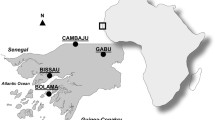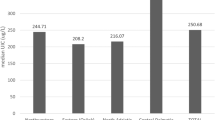Abstract
In the present study the iodine status of 300 adolescent boys and girls was assessed by clinical examination and biochemical tests. The clinical examination revealed the total goitre rate (TGR) to be 65.2% among boys, and 69.6% among girls. The visible goitre rate (VGR) was 17.7% among boys and 21.1% among girls. Nutritional status of all adolescents was found to be poor as compared to their well-nourished counterparts. Using discriminant analysis it was found that age, height and weight of the adolescents were significantly related to goitre grade (p<0.001), and they are important in prediction of goitre. Mild and moderate iodine deficiency were found to be prevalent among the adolescents. On the basis of urinary iodine/creatinine ratio, 38% of the adolescents were found to be suffering from mild iodine deficiency, i.e. average urinary iodine excretion between 50–100 mcg iodine/g creatinine. Moderate iodine deficiency (<50 mcg iodine/g creatinine) was found to be prevalent among 12.4% of the adolescents. The results of this study indicate a high prevalence of mild and moderate IDD among the adolescents studied.
Similar content being viewed by others
References
Khatri G. Magnitude of problem, India.ICCIDD Newsletter 1989; 5 (2): 12–13.
National Goitre Control Programme.Seminar on Goitre and Salt Iodisation. New Delhi: UNICEF, 1987.
Gopaldas T, Seshadri S, eds.Nutrition Monitoring and Assessment. New Delhi: Oxford University Press, UNICEF, 1987; 103–105, 191–193.
Hetzel BS, Potter BJ, Dulbert EM. In: Bourne GH, ed. Aspects of some Vitamins, Minerals and Enzymes in Health and Disease.World Rev Nutr Diet 1990; Vol. 62; 58–119. Switzerland: Basal Karger.
Karmarkar MG, Pandav CS, Krishnamchari KAVR.Principle and Procedure for Iodine Estimation—A Laboratory Manual.ICMR, New Delhi 1986; 10–12.
Hetzel BS. The prevention and control of IDD. ACC/SCN State-of-the Art Series.Nutrition Policy Discussion Paper No 3, 1988; 92–93.
National Institute of NutritionAnnual Report 1987–88: 98–99.
Agarwal KN, Agarwal DK. NGCP. A blueprint for its intensification. Current status of NGCP. Scientific report 1,NFI Bulletin 1983; 35–45.
Desai MP, Merchant SM, Mukherjee M et al. A study of the aetiology of goitres, and evaluation of the role of Iodine deficiency in school children in Bombay.H.N.M. Annual Report 1990–91; 27–30.
Pennington JAT. Iodine. In: Smith KT, ed.Trace Minerals in Foods. New York: Marcel Dekker, 1988; 249–289.
Hetzel BS, Thilly CH, Fierro-Benitez R et al. Etiology of endemic goitre. In: Stanbury JB, Hetzel BS, eds.Endemic Goitre and Endemic Cretinism. New York; John Wiley, 1980; 219–236.
National Institute of Nutrition.Annual Report 1985–86; 55–71.
Author information
Authors and Affiliations
Rights and permissions
About this article
Cite this article
Dodd, N.S., Godhia, M.L. Prevalence of iodine deficiency disorders in adolescents. Indian J Pediatr 59, 585–591 (1992). https://doi.org/10.1007/BF02832996
Issue Date:
DOI: https://doi.org/10.1007/BF02832996




